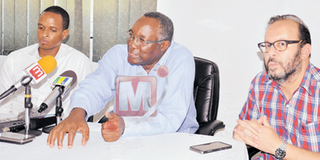Speech recognition to cut waiting time at Muhimbili

The Muhimbili National Hospital Executive Director, Prof Lawrence Museru speaks in Dar es Salaam on Monday about the voice recognition technology, which will shorten the waiting for patients seeking imaging services.
He is flanked by Yale School of Medicine Prof Frank Minja (left) and Prof Tarek El- Shayal from Global Healthcare and Education Initiative.
PHOTO | VENANCE NESTORY
What you need to know:
- The new technology helps doctors to encode patients’ information through voice recognition, thus helping to transfer the details of a patient from a doctor’s voice to imaging experts for processing.
Dar es Salaam. Patients at the Muhimbili National Hospital (MNH) who had to endure long waits for results of their imaging tests, such as X-ray and CT-scans, have a reason to smile following installation of high technology facility, which will shorten waiting time.
The new technology helps doctors to encode patients’ information through voice recognition, thus helping to transfer the details of a patient from a doctor’s voice to imaging experts for processing.
The voice recognition technology, which has been tested and applied on doctors at the MNH is a computer software programme with the ability to decode human voice.
The MNH Executive Director, Prof Lawrence Museru told reporters on Monday that the new technology means that three steps have been reduced in processing of patients’ information.
“We can’t say, with certainty the time it would take, but it will definitely take a shorter time now to process the images,’’ said Prof Museru when briefing reporters on the new facility at the national hospital.
“We used to have a situation where patients had to wait long to obtain results. This technology will also ease the burden on our staff because they had to move back and forth in trying to process such imaging tests,” he said.
An expert in radiology and biomedical imaging, Prof Frank Minja from Yale School of Medicine in the US helped facilitate the installation of this technology at the MNH.
He said: “We realised doctors are not good at typing, but they can speak. So, this technology helps a doctor in recording patients’ information by simply speaking through a voice recorder which then transmits the info into an image through a computerized system as the diagnosis is being made,” he said.
MNH becomes the first public hospital in Tanzania to have adopted the technology.



